Chichen Itza (Mexico) - description, history, location. Exact address, phone number, website. Reviews of tourists, photos and map.
Chichen Itza is the grandiose center of the Maya-Toltec civilization, which absorbed the knowledge, beliefs and ideas of these peoples about the universe and the world around them. The city is listed as a UNESCO World Heritage Site, and the Pyramid of Kukulkan located here has been declared one of the new seven wonders of the world.
Entrance to the territory - 220 MXN, the cost of guide services - 750 MXN.
Access is open from 8:00 to 17:00.
 |
| Chichen Itza |
History and Culture
The history of the city can be conditionally divided into two periods: the first lasted from the 7th to the 10th century, when it belonged to the Maya, the second came in the 10th century after the occupation of the territory by the Toltecs. In the middle of the 11th century, Chichen Itza became the capital of the Toltec state, and in 1178 it was defeated by the united army of the rebellious Mayan tribe from three cities: Mayapan, Uxmal and Itzmal. For a reason that remained an unsolved mystery, at the end of the 12th century the city was completely empty. The buildings of Chichen Itza were gradually covered with a continuous carpet of thickets of tropical plants, until archaeological and restoration work began here in 1920.
 |
| Chichen Itza |
The Toltecs worshiped a deity called Quetzcoatl or Kukulcan in the Mayan language, which means "feathered serpent", the images of which are adjacent here to the rain god Chak.
At present, Chichen Itza is the most fully and qualitatively restored Mayan city, annually attracting a huge number of tourists.
Where is and how to get to Chichen Itza
From Merida in 1 hour 45 minutes and 200 MXN you will be taken by a first class bus. The second class will cost 120 MXN, travel time is 2.5 hours. From Cancun it will be, respectively, 290 MXN and 2.5 hours for the first class and 200 MXN and 4.5 hours for the second.
 |
| Chichen Itza |
Shopping
On the territory of the complex there are a large number of merchants offering various souvenirs and crafts. Be careful: besides the fact that they are intrusive and will try to attract attention by any means, their goods are often of very low quality.
There are also several shops where you can buy souvenirs, clothes and jewelry.
Popular hotels in Chichen Itza
Excursions, entertainment and attractions of Chichen Itza
Unfortunately, since the beginning of 2006, climbing the structures has been prohibited, except for a few specially marked places. Don't forget your hat and sunglasses - during the daytime there is almost no shade. And, of course, you can't do without comfortable shoes.
In the evening, the city is illuminated by the lights of a light and sound show, during which a fabulous story is told in Spanish. The night landscape leaves an unforgettable impression, but be prepared for the fact that you will have to return in complete darkness - it will not be superfluous to have a flashlight with you. A ticket to the show costs 190 MXN.
Take binoculars with you - a large number of marvelous birds live in the area. And at night you can admire the sky strewn with myriads of stars.
There is also a small but fascinating museum on the territory of the complex.
 |
| Chichen Itza |
Pyramids and temples of Chichen Itza
The Pyramid of Kukulkan, or El Castillo, is a nine-stage pyramid 25 meters high, in fact, a huge calendar: each of the steps is divided into 2 parts, forming 18 terraces, symbolizing 18 twenty-day months of the year.
On the days of the spring (March 21-22) and autumn (September 21-22) equinoxes, the play of sunlight and shadow creates on the western balustrade of the main staircase the illusion of the body of a snake, “creeping” in the direction of the sun to its head, carved at the base of the stairs.
These days, Chichen Itza is so crowded that it is hardly possible to get closer to get a good look at what is happening. A week before and a week after these dates, the effect of the image is almost the same.
 |
| Chichen Itza |
El Caracol - located on a square platform, a round temple served as an observatory. The windows of the dome are framed with images of various celestial bodies on certain dates. A large field for playing ball (there are seven in total on the territory of the complex) is the largest of all created by the Maya, its length is 135 meters. And the Sacred Cenote is a natural well about 50 meters deep.
The temple of warriors (located on a low four-stage pyramid) is decorated with images of sacred animals carved from stone. The top is crowned with the figure of the god of rain. Nearby are the ruins of the baths, which had mystical significance in the life of the Maya, as a way to cleanse the body and soul.
On March 19, 20 and 21, the days of the "Declining Kukulkan" are celebrated, at which time dance, musical and theatrical performances are held.